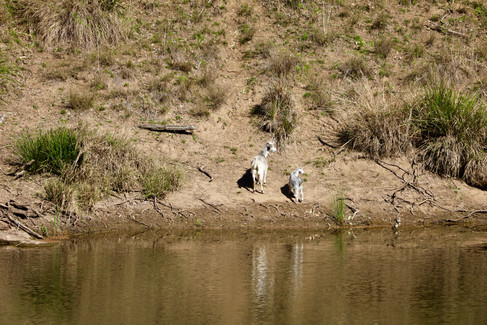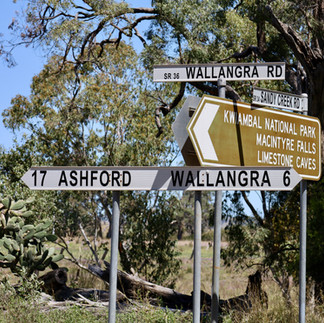KWIAMBAL NP.... NSW
- Woolgoolgaoffroad
- Oct 29
- 4 min read
Kwiambal National Park in the north of NSW is only 9200 hectares and is the traditional country of the Kwiambal people, who have descended from the Murri people of the north west that have lived in the area for thousands of years. There is evidence of their existence including sacred sites and hunting grounds throughout the park where Kwiambal ancestor's lived year round.

Located 80km north of Inverell, Kwiambal is a serene, peaceful place where European history dates back to 1827. Explorer and botanist Allan Cunningham known for his expeditions along the eastern seaboard into uncolonised areas, ventured through northwest NSW in 1827.
He was collecting plant species north of Inverell, in a supposedly uninhabited area, but found a squatter’s shack and cattle near what is known today as the township of Ashford. By 1830 settlers arrived in the north west slopes and Ashford was declared a village in 1860.

Now I’ve been to Kwiambal before nearly 10 years ago and I was keen to head back for some time out and to get back to nature. After a quick stop at Ashford it’s only a 30minute drive to the parks boundary.

Tobacco farming was a major industry out here between 1969 and 1994 and if you look around there are still a few of the old drying sheds left, although most are used for farm storage these days, made from Cyprus and Ironbark.

Unfortunately there’s still plenty of Prickly Pear cactus around, even Allan Cunningham noted back in his explore, that it was so thick that it could not be walked through.
One of the main attractions in Kwiambal are the limestones caves that were used for the mining of bat poo, or Guano that is high in phosphorus and nitrogen. Just near the entrance of the caves there are info boards highlighting Allan Cunningham’s travels as well as history of the limestone caves and the mining era.
It’s only a 300m walk to the cave entrance and day picnic area from the carpark where you’ll find toilets, shelters, a few tables and plenty of open paddocks where the kids can run around. Around the caves entrance and some of the roads through the park, you can spot fossils that seem like gigantic worm groves, these are called Rillenkarren, where acid rain water has run down the rocks over millions of years to create these unusual channels.

With a good torch it’s possible to safely explore the cave system where there are huge rooms and lengthly hallway type drives, some of the pathways lead to smaller cave rooms and others are massive. Look closely and you can see stalactites and stalemates and in some of the quieter caves little bats hold on tightly to the roof.

Just remember your pathway as there are no markers or formed trail, and if your torch goes out, its dark, very dark. The signs outside estimate two kilometres of cave system that most people can explore and a further three if you have specialised equipment. Fossils and bones have been found around the limestone cave system that date back to the Pleistocene era ( 11,000 to 2,5 million years ago ) and surprisingly they have included a Pigmy Possum, huge Kangaroo’s and a Thylacine.

Another drawcard to Kwiambal are Macintyre Falls and the walking tracks to areas called - the Pools, The Beach, Slippery Rocks and to the Gorge. There are viewing platforms for those who can’t or don’t want to hike to the bottom which give you different views of the ruggered terrain down to the Macintyre River and the magnitude of the granite gorges.
In the warmer months, hikers would be rewarded with a refreshing swim when exploring the bottom areas of the gorge to the many waterholes. At the trail head walk to the falls, there are toilets, shelters and bbq’s for the day trippers.
There are two camping areas in Kwiambal, which are Lemon Tree Flat and Kookabitta which are both on the Severn River. As usual booking is done online and both times I’ve been, Lemon Tree books out fast. There are only a few sites at Kookabitta which are suitable for all types of camping, like swags, RTT and offroad trailers.

At both camps they have been set up with drop toilets, bbq shelters and tables. Campsites at Kookabitta have their own picnic table and fire pit. Both camping areas have walking tracks to each other and Lemon Tree has The Junction walk out past the Dungeon lookout and to where the Severn and Macintyre Rivers meet.

Both have river access and are peaceful camps where birdlife and animals come down to water. The big grass area at Kookabitta attracts Wallabies in the afternoon and it’s an attractive setting against the wild hills behind the camping area.
Even tho Kwiambal is small and it's all about getting back to nature, I’m a big fan of the place where serenity and the peaceful nature of the area is the winner here, and for those who want to throw on a pair of hiking boots you’ll be kept busy for days.
WHERE IS KWIAMBAL
Kwiambal National Park is 80km north of Inverell (via Ashford, northern NSW). Set in rugged, remote gorge country, it has cultural and historical heritage.

WHAT TO SEE AND DO
There are two camping areas to set up base, Lemon Tree and Kookabitta both with essential facilities and booking is now done online through the NPWS website. Kwiambal is a hikers delight with plenty of trails to test your fitness, with waterfalls, swimming holes and picnic spots to be rewarded with at the end of the day. On the outer reaches of the park, old Tobacco sheds can be spotted in the paddocks which were once used to dry the product.
OTHER INFO
NSW NPWS website ( www.nationalparks.nsw.gov.au/visit-a-park/parks/kwiambal-national-park )has all the up to date information for the park, and to book a site. My suggestion to explore Kwiambal would be during Spring when wildflowers may bloom and the weather is a bit kinder. Summer and Winter temperatures can be extreme so be prepared if exploring in those seasons.

















































Comments